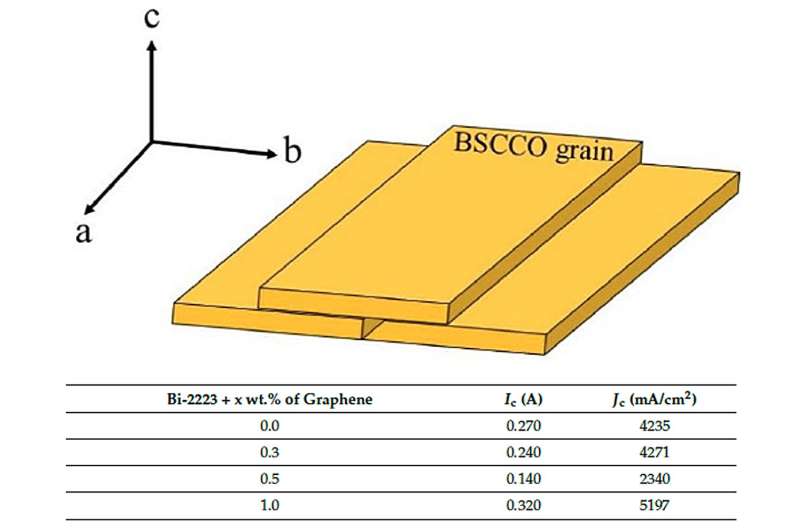This article has been reviewed according to Science X's editorial process and policies. Editors have highlighted the following attributes while ensuring the content's credibility:
fact-checked
proofread
A graphene addition for enhancing the critical current density of Bi-2223 superconductors

Superconductors are materials that offer zero electric resistance to the flow of current on being cooled down below a certain critical temperature. Typically, superconductors have a very low critical temperature, close to absolute zero. However, a class of superconductors, known as high-temperature superconductors (HTS) have a critical temperature above 77 Kelvin, the boiling point of liquid nitrogen. They have been extensively used for the development of superconducting devices in many industries.
Bismuth strontium calcium copper oxide, often referred to as BSCCO, is a class of HTS which has been widely studied and used in engineering, medical equipment, mining, and transport systems.
One of its members, (Bi1.6Pb0.4)Sr2Ca2Cu3O10 or Bi-2223, possesses the highest superconducting critical temperature, and has garnered significant attention for potential applications. However, limitations such as weak critical current density and weak magnetic flux pinning and a complex synthesis route have hindered the development and progress of Bi-2223 superconductors.
To address these shortcomings, a group of researchers, led by Professor Muralidhar Miryala from Materials for Energy and Environmental Laboratory of Superconducting Materials at Shibaura Institute of Technology and Professor Awang Kechik Mohd Mustafa from the Department of Physics of the Faculty of Science at Universiti Putra Malaysia, have investigated the effects of graphene nanoparticle addition on the phase formation and superconducting properties of Bi-2223.
"In this study, we report the effects on the critical temperature, critical current density, and structural and morphological properties of Bi-2223, when graphene nanoparticles are integrated into them using a novel co-precipitation method," explains Prof. Miryala.
This study was published in Nanomaterials. It is co-authored by Abdullah Siti Nabilah, Nursyahirah Kamarudin Aliah, Soo Kien Chen, Kean Pah Lim, Abdul Karim Muhammad Khalis, and Shaari Abdul Halim from Universiti Putra Malaysia, Abidin Talib Zainal from Jeonbuk National University, Baqiah Hussein from Dezhou University, and Hashim Azhan and Ermiza Suhaimi Nurbaisyatul from Universiti Teknologi MARA Pahang.
Since graphene possesses excellent electrical, mechanical, and chemical properties, and both graphene and Bi-2223 are grown as sheet-like microstructures, graphene nanoparticles are quite appealing as additives.
The team examined the phase formation and crystal structures of different Bi-2223 samples with 0.3, 0.5, and 1.0 weight percent graphene nanoparticles, respectively, using X-ray diffraction (XRD), and compared them to those of a pure sample. They also investigated the critical temperature of the samples using a method called alternate current susceptometry (ACS).
The XRD results revealed that a primary Bi-2223 phase and a secondary Bi-2212 phase, another BSCCO, dominated the samples. Additionally, the volume fraction constituted by the Bi-2223 phase was higher for samples with 0.3 and 0.5 weight percent graphene and slightly lower for the sample containing 1.0 weight percent graphene.
Moreover, ACS analysis revealed that the onset critical temperature, phase lock-in temperature, and coupling peak temperature—measures of superconducting abilities—decreased with an increase in graphene addition.
Interestingly, the sample with 1.0 weight percent graphene showed the highest critical current density and possessed the microstructure best aligned for the formation of Bi-2223 superconductors. "These results suggest that the addition of graphene nanoparticles, acting as impurities, have the potential to enhance the current density of Bi-2223 superconductors," says Prof. Miryala.
Explaining the potential future applications of Bi-2223 superconductors with enhanced current density, Prof. Miryala adds, "These superconductors have the potential to facilitate diverse fields, such as MRI imaging, power generation and distribution, renewable energy integration, transportation and aerospace, particle accelerators, electronics and quantum computing, environmental sustainability, industrial and manufacturing processes, and educational and scientific outreach."
More information: Siti Nabilah Abdullah et al, Microstructure and Superconducting Properties of Bi-2223 Synthesized via Co-Precipitation Method: Effects of Graphene Nanoparticle Addition, Nanomaterials (2023). DOI: 10.3390/nano13152197
Provided by Shibaura Institute of Technology





















